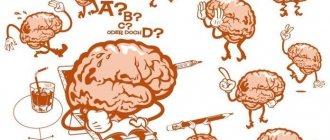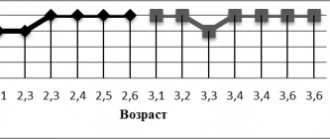All mental processes, including attention, have lower and higher forms. The lower forms are represented by involuntary attention, and the higher ones by voluntary attention. Direct attention also refers to a lower form of its development.
L.S. tried to trace the history of the development of attention. Vygotsky in line with the cultural-historical concept of its formation. He believed that the history of a child’s attention is the history of the development of the organization of his behavior. The key to a genetic understanding of attention must be sought outside the child’s personality.
The development of attention is a transition from simpler types to more complex types of attention. From congenital to acquired. For example, the development of attention will be the transition from involuntary attention to voluntary attention, because it works much better.
In different directions, the development of attention can proceed in parallel, including the improvement of all its types, and can only relate to certain types.
Are you an expert in this subject area? We invite you to become the author of the Directory Working Conditions
Its development can also proceed naturally and gradually improve as life experience accumulates and it grows older. This happens in all healthy people from birth to graduation.
A person can develop his attention purposefully, consciously taking thoughtful actions that are aimed at improving it. The natural and artificial development of attention has both common and different features:
- Attention develops naturally as the brain matures and experience accumulates, i.e. gradually and is a slow process. A natural process produces lasting change;
- And, on the contrary, its artificial development is an accelerated process and it is associated with the performance of special exercises that are designed to develop some of its properties or types. The changes that occur are not stable enough at first, and therefore need to be consolidated in the person’s subsequent life experience.
The following factors have a significant influence on the development of attention:
Finished works on a similar topic
Course work Development of attention 420 ₽ Abstract Development of attention 220 ₽ Test work Development of attention 190 ₽
Receive completed work or specialist advice on your educational project Find out the cost
- Speech that develops under the influence of learning;
- Imitating the behavior of adults;
- Mental activity.
In psychology, the main studies on the development of attention were associated with the study of the process of its natural development in children. This was due to the following circumstances:
- The study of attention by psychologists began relatively recently, so it was important to study its development in the form in which it exists and functions in human life, i.e. the natural process of its development;
- For a long time, it was generally not clear whether it was possible to develop a person’s attention artificially.
By the beginning of the second half of the 20th century, the first methods of developing children's attention were proposed, which were not entirely effective.
L. S. Vygotsky was one of the first to study the process of natural development of attention in children in Russia. He also developed a general theory of the development of human cognitive processes. This theory was called “The Theory of the Development of Higher Psychological Functions in Humans.” It has been applied to the study of attention development in children.
Stages of attention development
For the development of voluntary attention, school is of particular importance, because it is in the process of learning that the child learns discipline. During his school years, he develops perseverance and the ability to control his behavior. At the age of 9-10 years, qualitative changes already occur in the organization of the attention process. Emotionally neutral stimuli become effective stimulators of attention at this age. A decrease in attention characteristics is observed from the ages of 11-12 to 14-15 years. A significant restructuring of the child’s body occurs, which is accompanied by deviations in attention - increased fatigue and emotionality occur, and a decrease in cortical control occurs. And only towards the end of adolescence is an optimal attention system established.
L.S. Vygotsky identified 4 stages in the process of the genesis of voluntary attention:
- Stage one. Its essence comes down to the fact that an adult controls the behavior and consciousness of a child using a certain means. These means can be the index finger, speech accompaniment of an adult. At the beginning of attention control, notes L.S. Vygotsky, it is the indication that counts, so the history of voluntary attention should begin with the history of the index finger. At this stage, this is an interpsychic action and it is carried out between people on the external plane;
- Stage two. The child at this stage becomes a subject who uses psychological tools to control the behavior and consciousness of another person. Now he, with the help of his own index finger and speech accompaniment, draws the adult’s attention to the object he needs. This control action exists on the external plane as an interpsychic action;
- Stage three. The methods of controlling consciousness and behavior that people applied to him, and he applied to them, the child begins to apply to himself. The action still takes place on the external plane and is accompanied by the egocentric speech of the child. But the child turns the action on himself. At this stage, the internalization of the action of attention control begins. It acquires its finished form only at the next stage;
- Stage four. The action of controlling your attention at this stage becomes an internal action itself. The support for its implementation is the mental image and inner speech.
The scientist thus showed that the development of voluntary attention, as a higher mental function, occurs according to the general law of the development of higher mental functions.
Let us summarize what has been said once again. From the very beginning, the child's attention is controlled. At first it is led by adults. Then the child moves on to self-management of his attention - this means he masters voluntary attention, using the same means that was used in relation to him. Having mastered speech, the child first controls the process of attention of another and only then his own attention.
Reaching the level of an adult occurs when the child masters the internal means of controlling attention. As a result, the dynamics of the development of voluntary attention in further ontogenesis is not expressed, but it acquires individual characteristics.
In general, psychologists distinguish two main stages in the development of attention:
- Preschool development stage. Attention at this stage is caused by environmental factors;
- Stage of school development. There is a rapid development of internal attention, i.e. mediated by the child’s internal attitudes.
How is attention formed in children?
There are several factors that influence the speed of formation of the skill of attention during the learning process. Here are some of them:
- individual pace of learning;
- absence of long pauses in the learning process;
- reliance on active mental activity (application of generalization and comparison tasks, searching for examples and drawing conclusions);
- reliance on existing knowledge and skills;
- accompaniment of intellectual activity with special physical activity;
- absence of external stimuli that attract involuntary attention and distract from the cognitive process (loud remarks, comments, sudden movements, music and conversations);
- clarity and brevity of explanations of adults/conditions of the task that needs to be solved.
Cultivating involuntary attention
In the education of involuntary attention in children, a prominent place is occupied by the formation of the ability to see and hear, observe facts and phenomena, and strive to become more fully and better acquainted with reality. To this end, the child must be introduced from an early age to the richness and diversity of the world around him, notice what is around him, and learn to respond to any change in the environment.
The learning process will be attractive for a child if he shows interest and emotions, which are the main condition for the appearance of involuntary attention. Of course, first of all, it depends on the material being studied, the way it is presented and the clarity of teaching. Involuntary attention is caused by the use of paintings, models, demonstration of experiments, the use of specific facts from life, etc. For younger schoolchildren, involuntary attention is simply necessary. Any visibility requires compliance with a number of conditions:
- Correctly organize the child’s perception;
- Set a specific task - answer a question, make a comparison, discover something new, etc.
- Learn to notice what needs attention.
Work organized with clarity activates the child’s thoughts, teaches him to be attentive, highlight the essential, and notice the main thing.
Involuntary attention is attracted by a qualitative explanation of the material being studied, bright in form, rich in content and emotionally rich. The presentation of any material should awaken thought, make you think about the questions that arise, and evoke a desire to find out what will happen next.
To attract and maintain attention, the activity of the children themselves is of great importance; it is important that they not only listen passively, but also act themselves - ask, answer, conduct experiments, etc. The general cultural level is also an important condition for attention.
Factors influencing attention
Age-related characteristics of attention are associated with the participation of various parts of the brain in thought processes. The effectiveness of the work performed depends largely on environmental factors.
Some objects are distracting. For example, bright colors, extraneous irritating sounds, emotional discomfort when communicating. At the same time, others help to concentrate. If it is, for example, silence or calm music, a discreet color scheme in the interior design.
However, being in a work environment for a long time also negatively affects concentration and ability to work. Therefore, it is worth taking small but regular breaks of 10-15 minutes. During this time, you can do some physical exercise. If possible, have time to drink tea or coffee.
Of course, fluctuations in the level of mental activity throughout the day are of great importance. As you know, scientists have proven that the highest efficiency is observed from 9.00 to 12.00 noon and from 15.00 to 19.00 in the evening. It is best to plan your working day taking into account these features.
Edible, inedible
The speed of conscious switching of attention is a well-trained property of human attention. An example of an exercise for training switching speed is the children's game “Edible, Inedible.” The participants of the game sit in a circle. The presenter, in turn, throws the ball and names the objects. If the object is inedible, then the participant to whom the ball is thrown must not catch it, and, conversely, edible objects are caught. A successful participant takes the place of the presenter.
Thus, by training your switching speed, you increase your ability to distribute attention, that is, you increase your level of information processing in multitasking mode.
Feminine trait
The cognitive ability to distribute attention is an important quality for the effective implementation of assigned tasks in everyday life.
Image by Gerd Altmann from Pixabay
It is a known fact that women, by nature, are more prone to multitasking and have increased resistance to stress factors.
This has developed historically, and is due to feminine nature itself. At the everyday level, the distribution of attention has the form of proper planning of a sequence of processes: clearly determining the priority and sequence of goals, while taking into account the conditions and influence of external factors, can be considered an almost genetic, female trait.
Psychological theories of attention
Throughout the history of psychology as an independent science, there have been (and continue to exist) different ideas about what attention is. Let's look at the most important, in our opinion, theories of attention.
In 1879, Wilhelm Wundt founded the world's first psychological laboratory in Leipzig and began studying consciousness through introspection. Consciousness began to be studied simultaneously with attention, because it makes some impressions of consciousness clearer and more distinct than others.
Wundt believed that consciousness is “the sum of our conscious impressions.” To understand consciousness, the scientist used I.F. Herbart’s idea of the metaphor of the visual field. As in the visual field, consciousness can be divided into three zones: the fixation point, the central region and the periphery. The point of fixation of consciousness contains the most clearly perceived content. The fixation point of consciousness is surrounded by a central region in which many impressions are clearly perceived. Adjacent to the central region is the “periphery of the visual field,” in which objects are perceived rather blurry.
Wundt wrote that there is a term “attention” for the central part of the visual field of our consciousness. The scientist understands attention as “a mental process that occurs with a clearer perception of a limited area of content compared to the entire field of consciousness.” Therefore, we can say that those impressions that at a certain point in time stand out from the rest with particular clarity are the center of attention.
Wundt decided to find out what the span of attention is, that is, how many objects can be clearly perceived by a person at the same time. A representation is said to be clear because of its own properties, and it is clear when it can be distinguished from other representations.
Experiments to study the scope of attention were carried out with visual material. Wundt used the tachytoscope to study the stability of attention. The device can be used to present a series of symbols (letters) to a person. The screen covering the image is raised momentarily, and the subject must direct his gaze to as many letters as possible. If the subject concentrates on a point in the center of the screen before the image is presented, then at the moment of presentation he will be able to clearly see a very small number of objects. Inexperienced observers covered 3-4 units with their gaze, while experienced ones increased their attention span to 6. Modern researchers provide the same data.
Attention, like consciousness, has dynamics: new elements enter the field of attention and displace previous contents to the periphery. Two terms are used to describe these processes. Perception is the “actual entry of some content into consciousness,” and apperception is the enhancement of concentration in the focus of attention. With apperception, the content of consciousness becomes clear and distinct. Apperception allows you to expand perceptual units and comprehend the meaning of the whole. This happens, for example, when reading a word consisting of letters.
The American scientist W. James, a classic of the psychology of consciousness, understood the phenomenon of attention differently. He believed that consciousness is a “flow.” Just as a stream flowing through a wide meadow cannot cover the entire space, so consciousness cannot contain the entire surrounding world and the inner world of a person. “The area of our consciousness, naturally, seems very limited in comparison with the huge field of external influences on the sense organs and with the mass of new impressions constantly arriving from the outside. "
From the principle of limited consciousness follows its selectivity. It is directed towards certain objects or perceptions that become objects of attention. However, as a rule, attention cannot be held on the same object for a long time. To illustrate this fact, Gems quotes the words of the German physiologist and psychologist Helmholtz: “If we want to direct our attention to a specific object, we must discover more and more new aspects of it.
James believed that attention does not exist as a separate mental process. as a separate process. In his opinion, the choice of an object of attention is determined by the activity of the nervous system in its three aspects.
The setting of the senses, which determines the clarity of perception and the direction of attention depending on the turn of the head and the direction of its gaze. When we look or hear something, we involuntarily adjust our eyes and ears, and also turn our head; when smelling and tasting, we tune our tongue, lips and nose to a given object, etc. Therefore, any object capable of awakening our sense organ causes an adaptation of the sense organ, which leads to both a feeling of activity and increased clarity of consciousness of the given object. When we turn to our thoughts, we can talk about the line of sight “inside ourselves.”
Ideological stimulation of a certain center in the human brain. According to James, voluntary attention to an object occurs only when we have an idea or image of the object in our minds and we can anticipate it. The scientist called the process of anticipating the object of attention “preperception.” This phenomenon is associated with the work of memory and imagination, which provide material for the image of an object.
Based on the concept of precognition, W. James gives pedagogical advice on how to develop students' attention. The child can direct attention to an object that was once pointed out to him and about which he already has an idea. “It is best if the subject itself is interesting, and when we teach children we should always try to connect the new information we give them with objects with which they are associated through previous experience.”
Blood flow to the corresponding brain center. Although James recognizes this state as only physiologically plausible, in modern neurophysiology it has become one of the most important sources of data on the mechanisms of attention.
One of the most famous theories of attention was proposed by the French psychologist T. Ribot. Describing attention as processes of consciousness, Ribot considered attention as mental monoideism. This state is opposed to the usual flow of feelings and thoughts in a person’s consciousness, i.e. polyideism. When attention selects one impression, other perceptions are somehow grouped around the central impression. T. Ribot defines attention as “relative mental monoideism, accompanied by involuntary or artificial adaptation of the individual.”
Distribution as a property
Attention is characterized by five main properties: stability, concentration, switchability, distribution and volume.
Giphy
Let us dwell in more detail on the property of attention distribution. Have you ever done several things at the same time? If yes, then the principle of how attention is distributed is well known to you. The ability to hold several different objects or actions in the zone of active attention is called attention distribution.
Remember yourself at school: you were sure that you were in the field of view of the teacher, but your neighbor, or your deskmate, were also sure that the teacher was watching each of them personally. Proper distribution of attention is a professional trait of a teacher.
A good example of the distribution of attention is the driver of a car: the success of driving a car directly depends on the driver’s ability to maintain control in his zone, the attention of other road users, the technical performance of the car, and external environmental factors.










